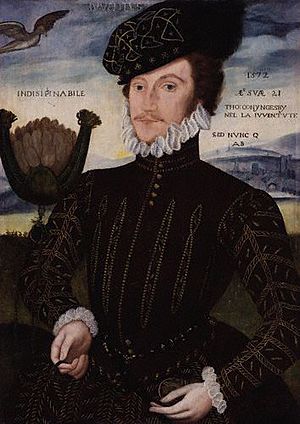Thomas Coningsby facts for kids
Sir Thomas Coningsby (born October 9, 1550 – died May 30, 1625) was an English soldier and a Member of Parliament. He is known for a diary he wrote about military actions in France in 1591. He also had some disagreements about local politics in Herefordshire.
Contents
Early Life and Military Adventures
Thomas Coningsby was the son of Humphrey Coningsby. His family lived at Hampton Court, Herefordshire. His father worked for Queen Elizabeth.
In 1573, Thomas Coningsby traveled to Italy with Sir Philip Sidney. They were good friends for a long time, even though they had a disagreement during their trip.
Later, in 1591, Coningsby went to Normandy, France, with the Earl of Essex. He helped in the siege of Rouen, fighting against a group called the League. He was in charge of checking the English soldiers and often met with Henry of Navarre, who was the King of France. On October 8, 1591, the Earl of Essex made him a knight.
Thomas Coningsby also held important local jobs. He was the High Sheriff of Herefordshire in 1582 and 1598. He was also elected as a knight of the shire (which means a Member of Parliament) for Herefordshire in 1593, 1597, and 1601.
Disagreements with the Croft Family

Sir Thomas Coningsby had a long-standing disagreement, or "feud," with a neighbor named Herbert Croft (died 1629), who lived at Croft Castle. Things got heated, and they even had a fight during a court session in Hereford in July 1588, where a supporter of Croft was killed.
In 1601, Coningsby wrote to Sir Robert Cecil because he disagreed with Herbert Croft being chosen as the Steward of Leominster. Coningsby felt he should have the job because his father had been the Steward, and he owned property in the town. He hoped Cecil would help him because his wife, Philippa, was related to Cecil.
Working for Queen Anne of Denmark

After James VI and I became King of England in 1603, his wife, Anne of Denmark, became Queen. Sir Thomas Coningsby was chosen to be part of a group that managed the Queen's lands in England. These lands were called "jointure" lands, which were given to the Queen for her support.
Coningsby was asked to check on the Queen's properties in Herefordshire and Worcestershire. These included places like Kingsland, Marden, and Leominster. He and the other advisors were invited to meet the Queen once a serious illness (the plague) had passed.
In 1604, Coningsby reported on the rents from the royal lands to Robert, Lord Sidney, who worked for the Queen. Coningsby used this chance to criticize his rival, Herbert Croft, saying that his new role was "very displeasing" to Croft.
Sir Thomas Coningsby and his wife had their portraits painted in 1612. One painting even showed him with "Crickit the dwarf."
After Queen Anne of Denmark died in 1619, the lands in Leominster were given to the Marquess of Buckingham.
Later Life and Legacy
In 1614, Sir Thomas Coningsby founded a special place called Coningsby Hospital in Hereford. It was a home for old soldiers and servants, which he called 'Coningsby's Company of Old Servitors'. Today, you can still visit this hospital on certain days and learn about Sir Thomas Coningsby and his impact.
On November 12, 1617, he joined the Council of Wales and the Marches, a group that helped govern Wales. An unmarried cousin, Joyce Jeffreys, came to live at Hampton Court in 1617 to be a "constant friend" to Philippa Coningsby.
Sir Thomas Coningsby passed away on May 30, 1625, when he was 74 years old.
Family Life
Thomas Coningsby married Philippa, who was the daughter of Sir William Fitzwilliam. Philippa was also a cousin of Sir Philip Sidney. They had six sons and three daughters. Sadly, most of their sons died before Sir Thomas did.
Their children included:
- Fitzwilliam Coningsby, who had a son named Humphrey Coningsby. Humphrey was the father of Thomas Coningsby, 1st Earl Coningsby.
- Katharine Coningsby, who married Francis Smallman.
- Elizabeth Coningsby, who married Sir Humphrey Baskerville.
- Anne Coningsby, who married Sir Richard Tracy in 1608.
His Diary
Sir Thomas Coningsby wrote a diary about the English soldiers' actions in France in 1591. The diary describes events day by day for two periods: from August 13 to September 6, and from October 3 to December 24. It then ends suddenly. The original diary is kept at the British Library. It was first printed in 1847.
|


